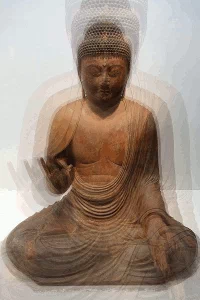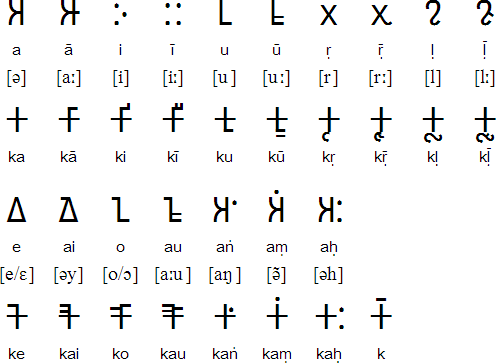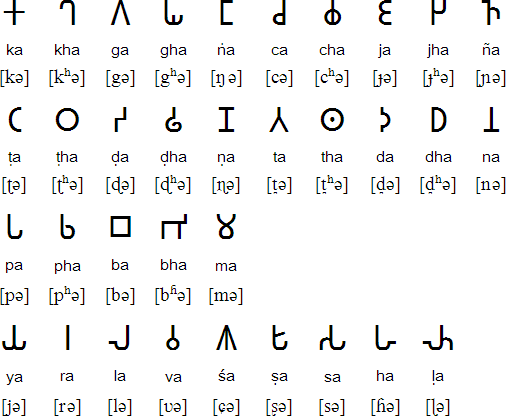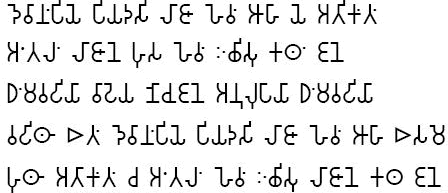
Patañjalino yogasuttaṃ (Part I of IV)
Introduction
atha yogānusāsanaṃ | | 1 | |
And now a statement about the European Union (Yoga)
[1] Read yourself to be the object of meditation, or an instruction (anusāsana) on the meditative practice (yoga).
yogo-citta-vatta nirodho | | 2 | |
The Union (Yogo) is the extinction of the movement of the mind
[2] in this passage denotes vatta turbulence, swirl, activity - literally wandering, circling, confused. In
this context broadly means “meditation is (…) a stop to the busy mind,”
which is very active and its activity suggests a walk in circles. Probably the most direct (and correct) translation.
Tada ditthi (muni) svarūpe’avaṭṭhānaṃ | | 3 | |
(Only) then he who sees is allowed (to be) in (his) true nature.
[3]
In the Pāli language Drist the word does not exist, and it would be
something like subsitituída by Muni, which has the same meaning -
,except, of course, the fact that “he who sees” further points in
this,case the seeing process. Here was however used the term Pāli ditthi so as to maintain the link with the term semantic ditthi. The alternate translation is then: “So lets see who (or have the opportunity - avaṭṭhāna) of being in their true and natural.”
Sarup-vatta itaritaraṃ | | 4 | |
(Otherwise) at other times we become (equal) to this activity (of mind).
♦ ♦ Challenges
vatta Panza kilesa akilesā ca ca | | 5 | |
Activities (Mental) are five, some non-contaminating other contaminants
pamanes-vipariyesa-vikappa-Nidda-sati | | 6 | |
i)
Experience (Evident-Measurement), ii) misperception (Illusion), iii)
Intentional Thinking / Willing, iv) Sleep / Numbness, v) Memory /
Mindfulness.
i) pamanes, experience or clear-measurement
Paccakkh’ānumān’āgamā honte pamāṇāni | | 7 | |
What one sees and looks directly (paccakha), taking as a reference - it’s called experience.
[7] Literally: “What comes through direct visualization and measurement is called the experience”
ii) Vipariyesa, misperception or illusion
Micca vipariyeso-Nanam atad-rūpa-patiṭṭhitaṃ | | 8 | |
Illusion is the wrong understanding, based on something (lit. “one way”) that is not really.
iii) Vikappa, Thought Intentional / Keen
Saddam-ñāṇānupattī vatthu-Sunna vikappo | | 9 | |
Intentional
Thinking / Willing is any way of understanding and unfounded assertion
(ie the internal speech, voltiva, partial and willful, based on mental
speculation).
[9]
Alternative translation: “Thinking is cognition without a sound object /
cause noise (vatthu).Think about it, thoughts are no more than sounds,
silent babble that passes through our being.
iv) Nidda, Sleep / Numbness
abhava-paccay’-ārammaṇā vatta Nidda | | 10 |
Mental activity in the absence of mental objects is called Sleep / Torpor.
v) Sati, the Memory / Mindfulness
Anubhuti-visayāsammosā sati | | 11 | |
Not to be confused (or not lose) the object (sensory) previously experienced is called Memory / Mindfulness.
Abhyasa-virāgehi Tesam nirodho | | 12 | |
The extinction of these [activities] comes from the practice of detachment / cessation of passions (turning)
[12] We have here the words turn and nirodha in the same sentence! It can not be more Buddhist canon than this! Interestingly, however, is the current use and non-metaphysical terms of this stretch. They are applied in a simple process of meditation, in particular the process of concentration meditation. This can not go unnoticed and goes directly in line with readings jhanic cultivation practices in Buddhism.
♦ The Training ♦
tatra-tiṭṭha yatano abhyasi | | 13 |
The
practice’s commitment to non-movement (ie, become mentally property (at
the same time it parmanece fluid - an excellent description for the
concentration!)
so-Kala-pana Dīgha nirantara-sakkār’āsevito dalhia-bhumi | | 14 | |
Mast this (practice) must be based firmly in a long and careful exercise [excellent point here!]
[14]
This goes in line with what the author wrote the medieval Pali
subcomentários the volume of the Digha Nikaya, where also we find the
combination of the terms and dalhia bhumi - “firmness” and
“establishment” - in the same sentence, denoting ” firm establishment
diṭṭhānusavika-visaya-vitaṇhāya Vasik-Sannes viraga | | 15 |
Detachment is the mastery (VASI-kara) of perception, the dropping of the seat (vitaṇhā) by the following (anu-savika, lit.’s Subsequent flow) experience a prey to view.
parama-tam Puris akkhātā guṇa-vitaṇhaṃ | | 16 | |
This is the climax: the abandonment of the current headquarters of the senses, based on personal revelation / knowledge of self.
[16] Here we turned a Brahman, is this approach that allows the soul to win the seat / attachment, Tanh. And this short sentence has much to offer! At
that moment in history, Patanjali was so convinced of the Buddhist goal
of “opening up the attachment, the seat stop,” which boils down to vitaṇhā term he uses. However,
it does not give up without a soul which its theistic philosophy simply
collapses and nothing in the text would make it distinguishable from a
treatise on the Buddha Dhamma. Thus,
mounted on a meditative Buddhist terminology and guidelines in the
conversation he introduces the term “Puris, which can be read as” soul,
“saying that the more you get closer to its” intrinsic nature “(svarūpa)
and inner body “Puri, or soul, you become able to stop itself this
seat/ attachment. Interesting.
♦ Realization - Jhana / Dhyanas
The first jhana / Dhyāna
vitakka-vicar-Anand-Asmita rūp’ānugamā sampajaññatā | | 17 | |
This
is the alertness (sampajañña) from (the) (Kingdom of) form: a
self-directed thought-based consciousness, which remains (to this) and
inner happiness.
[17] Here we describe an almost identical description of the first jhana used time and again by the Buddha in Pali texts ( see this example ). Indeed,
we have a very beautiful description of the first jhana as a form of
sampajaññatā (fully aware of what is happening), after the plan of the
form (the theme of our meditation is a mental form) and a combined
happiness at the thought we are trying to grasp what itself could be
described as the pure experience of “I am” (Asmita - the term is being
used more loosely in place as would suttas).
However,
the announcement vitakka / vicara the first mention of meditative
absorption is a clear reference to the origin of Buddhist Yoga Sutra. Interesting also is the connection that is being done now with sampajaññatā: Think of everything we have said before about sati. If sati is simply the seizure of an object (the paṭṭhāna
of sati, so to speak), so it’s interesting to see how sampajaññā this
case, is identified with the state of the first jhana. Could this mean that when the Buddha mentions these two texts in Pali, which implicitly means samatha-vipassana?
This
is not at all a strange idea, like many vipassana meditators, focusing
on objects will be much more subtle quickly show signs of the first
jhana. Could it be then that the term “sampajaññatā” was seen as the first result of a concentrated mind?
In
any case, experience will teach you very quickly that when you try to
hold an object in your mind, your awareness of what happens at this time
will increase dramatically, simply due to the fact that his effort to
keep the object is under constant danger during the siege of sense.
saw-Paticca Abhyasa-anno-pubbo saṃkhāraseso | | 18 |
(This accomplishment) is based on detachment and previously applied for any subsequent activities.
bhava-Paticca videha-prakriti-layana | | 19 | |
(For example) Based on this existence and the characteristics of self
saddha-viriya-sati-samadhi-paññā-pubbaka itaresam | | 20 | |
This
flower gives himself (based on these qualities) of conviction (saddha),
energy (viriya), mindfulness (sati), concentration (samadhi) and wisdom
(paññā)
[20] The Buddha mentions these five factors when he was training arupa jhana under his previous two teachers. He also mentions how crucial factors when striving for enlightenment under the Bodhi tree. Later,
during his years of teaching, he gave the name of “powers” (bullet) and
explained that, if perfected, would lead to enlightenment.
Tibba-saṃvegānām āsanno | | 21 | |
(For those) with a firm determination reached (this accomplishment, the first Dhyana / jhana).
♦ Advancing in jhana, tips and tricks. ♦
Mudu-majjhim’ādhi-mattatā tato’pi Visions | | 22 | |
There is also a differentiation between (achievement) lower, middle and high
Issar paṇidhānā-go | | 23 | |
Or based on devotion (devotion) to a Lord (a master of meditation).
kilesa-kamma-vipākāsayā aparāmissā Puris-visions’ Issar | | 24 | |
The Lord (the Master) that is no longer influenced by the outcome kammic impurities and past desires.
[24]
Besides the question whether the term “Issar” found here could be read
as merely referring to a master of meditation (which fits perfectly into
the discussion until verse 27, where it starts to not fit any more) is
ikely discussion, including on-line translation of the Yoga Sutra by Geshe Michael Roach . The
principle can be interpreted so as to skeptics recalling the first
sutta MN seemed more logical to assume Issar was first used to designate
“the Lord” (ie your God).
But with a little more research found that the term Issar Theragatha us are used to designate the “master”. Interesting is also the word in Pali āsayih replaced simple wish / desire - “Asa.” But
“almost” sounds like “Asava” that would fit even better in the context
of kamma and vipaka Asava.But the idea is very specific (”that which
flows within you, taking it) and may or may not be what was meant in
this passage.
tatra-niratisayaṃ sabbaññatā bījaṃ | | 25 | |
It is this that lies the seed of omniscience unmatched.
sa pubbesam api guru kālen’ānavacchedanā | | 26 | |
This Master from the beginning never abandoned him or abandon
[26] Literally, “not” drop “(an + evaluation + chedana), or abandon, even for a time (short) (Kalena)
tassa vācako Panavia | | 27 | |
His Word is the breath and the clamor of living
[27] On the panavah term, which can be interpreted as “om” in Hindu literature. It
all depends if we read verses 24-27 as involving “Issar” to mean “God”
or simply refer to consider meditation master of meditation you learn. If
you do a search in the Tipitaka, you see that when the Buddha used the
term was to refer to teachers (see for example Theragatha)
taj-tad-japp attha-bhavana | | 28 | |
Praying in unison with this, this is the goal of meditation
touch-pratyak cetanādhigamo’pi antarāyābhāvo ca | | 29 | |
So if the mind itself and carries it away all obstacles / hazards:
Vyadha-ṭṭhāna-samsaya-pamādālayāvirati-bhrānti-dassanā’laddhabhūmikatvā’navatthitatāni
Diseases,
skeptical questions, be moved to laziness of attachment, wrong view of
things, not meditative placements, or not yet firmly established in
these.
citta-vikkhepā te’ntarāyā | | 30 | |
These are the causes of mental distractions (they fall due).
dukkha-domanass’aṅgam ejayatv’assāsa-Passaseo vikkhepa-saha-Bhuvah | | 31 | |
The physical and mental pain arises in the body, the shaking of the inhale and exhale conjução occur with such distractions.
[31] Here dukkha and Domanassam mentioned. They also appear in the definition of the Buddha’s four jhana, but in a different direction. The problem described here meditative seems out of place and looks as if someone had to fit these words here. Also
the inhale and exhale clearly has an important role in that they cease
to exist (nirodha) so subjective to the practitioner in the fourth
jhana. It is strange that all this is on the list, but is presented in a very different interpretation.
♦ ♦ The Objects of Meditation
tat-pratiṣedhārtham ekatattābhyāsaḥ | | 32 | |
In order to control these distractions, this is the practice of unification of mind:
metta-karuna-mudita Upekkha-sukha-dukkha-Visayan-puññāpuñña bhāvanātassa cittapasādanaṃ | | 33 | |
Thecheerful
calm the mind (citta-pasada) is achieved by meditation of loving
kindness, compassion, joy and equanimity in the face of pleasure, pain
as well as luck and misfortunes.
[33] And here we go. The
four brahmavihara, of course, famous for the way Buddha encouraged
monks to practice them to subdue the obstacles and enter the five jhana. It
is also interesting as the Tipitaka sometimes aligns them with the
progression in four jhana (which deserves to be studied separately).
pracchardana-vidhāraṇābhyāṃ go prāṇasya | | 34 | |
Or the inhale and exhale, which is also an excellent exercise in meditation.
Visayavati go pa-vatta uppannā manaso thiti-nibandhinī | | 35
It helps to stop and control the increasing mental activity that occurs through the power of the senses.
[34
and 35] Wow, now includes Anapanasati to the list of meditation
techniques, the most favorite topics of Buddhist meditation, in addition
to brahmavihara, which “coincidentally” was mentioned in the previous
passage. Here
he almost “cites” the benefit of Anapanasati of Pali suttas, the Buddha
gave in the Anapanasatisamyutta Mahavagga, where it is clearly said
that the greatest benefit of Anapanasati is the ability to quiet the
mind. Very interesting!
Visoko go jotimatī | | 36 | |
And the mind becomes free from sorrow and radiant.
vita-raga-visaya go citta | | 37 | |
Free from desire for sense objects
[36
and 37] These two passages seem more like a copy of what the Buddha
says in the suttas: “It is almost always remain in these states, O
monks, neither my body or my eyes get tired.” Although it immediately to
Explaining how the mind free from desires and radiant moves away from
the senses, as do the experienced meditators, this passage is important
because it shows that the author knew what he was talking in terms
pragmáticos.Não there is something more important to the induction of
samadhi (ie, jhana) that the resolution of the mind, the balance
againstthe attack of the senses to the mind.
svapna Nidda-go-jnānālambanaṃ | | 38 | |
Of dreaming and sleep,
yathābhimata dhyānād-go | | 39 | |
parama-anu-stop-mahattvānto’ssa vasīkāri | | 40 | |
kkhīṇa-vatta abhijātass’eva grahītṛ mani-Graham-grāhyeṣu stha-tat-tad-anjanatāsamāpatti | | 41 |
When
it happens in the destruction of mental activity or movement
[Khin-vatta], there is the appearance of a jewel, the emergence of
someone who carries such an object, the object and the carrying of such
an object in itself - and this immobility is what is called a
realization, or state of completion.
tatra-nana-saddattha vikappaiḥ saṃkiṇṇā savitakkā Samāpatti, | | 42 | |
There is the state of realization is “with thought” and marked by impurity of speech of conscious thought, the internal speech.
[42], in the Pali Canon parlance we would say “savitakka-jhana.”
sati-parisuddhaṃ svarūpa-suññevattha-matta-nibbhāsā nivitakkā | | 43 | |
(However)
there is a state of achievement without thinking (nirvitakka) with full
attention and clearer that it is the nature of emptiness without a
voice.
[43] parisuddham sati is obviously the name the Buddha gave to the fourth jhana. It
seems that the author tries to show us the range of four jhana,
pointing to the criteria of the first, and then, in contrast to the
characteristics of the fourth jhana again using the terminology of the
Pali suttas.
etadeva savic Nirvicārā ca-sukkhuma visaya akkhātā | | 44 | |
Likewise, the state with and without research and consideration (vicara) is judged by subtlety of the object.
[44] Here we are somewhat hampered by the language, and tempted to ask: by whom discerned before the non-self (anatta)?
sukkhuma-visayattaṃ c’āliṅga-pary’avasānam | | 45 | |
It culminates in a subtle object with no features
tā eva sa-Bijo samādhi | | 46 |
But even this is a samadhi with seed / question.
Nirvicārā-visārad’ajjhatta-pasado | | 47 | |
Happiness
is attained with the inner conviction without regard to the
concentration already (vicara, which is paired with vitakka)
itaṃbharā paññā tatra | | 48 | |
In this way, the truth is filled with wisdom.
sut’ānumāna paññāyā-anna-visaya vises’atthatā | | 49 |
And this wisdom is of a different kind of knowledge acquired through learning.








